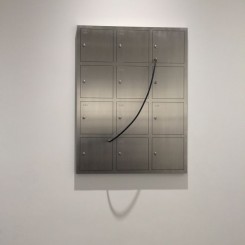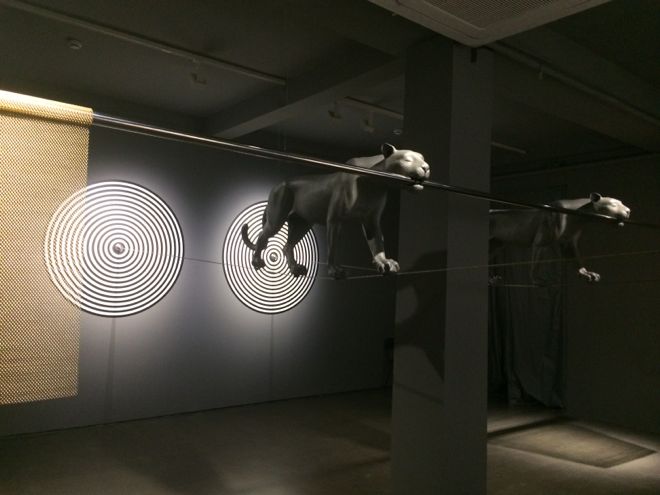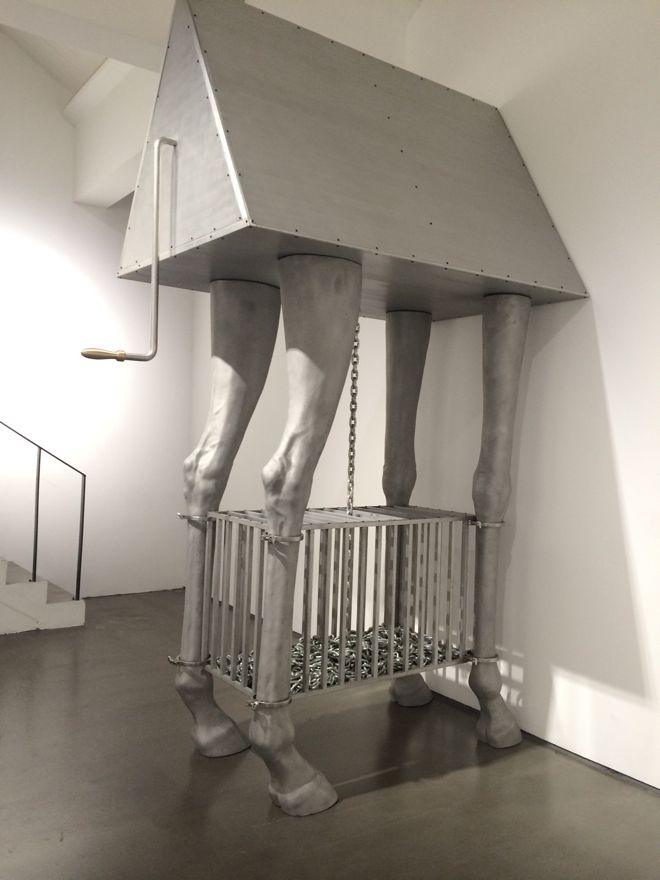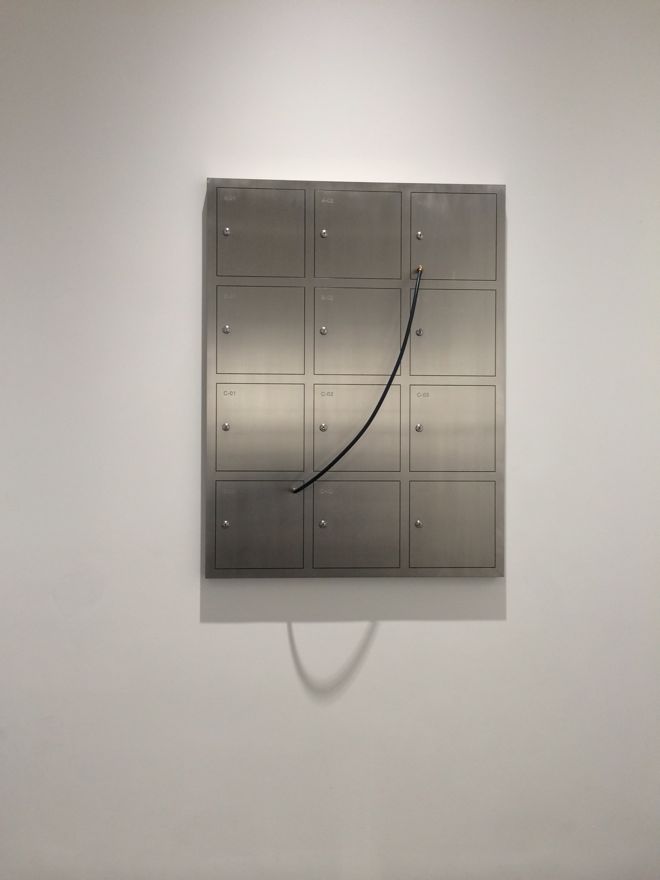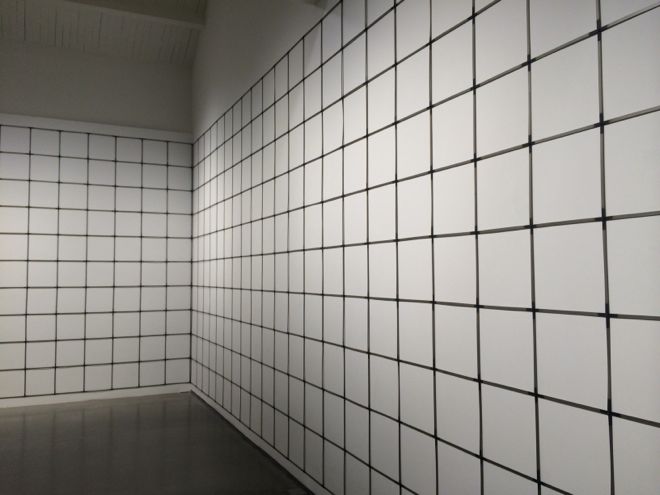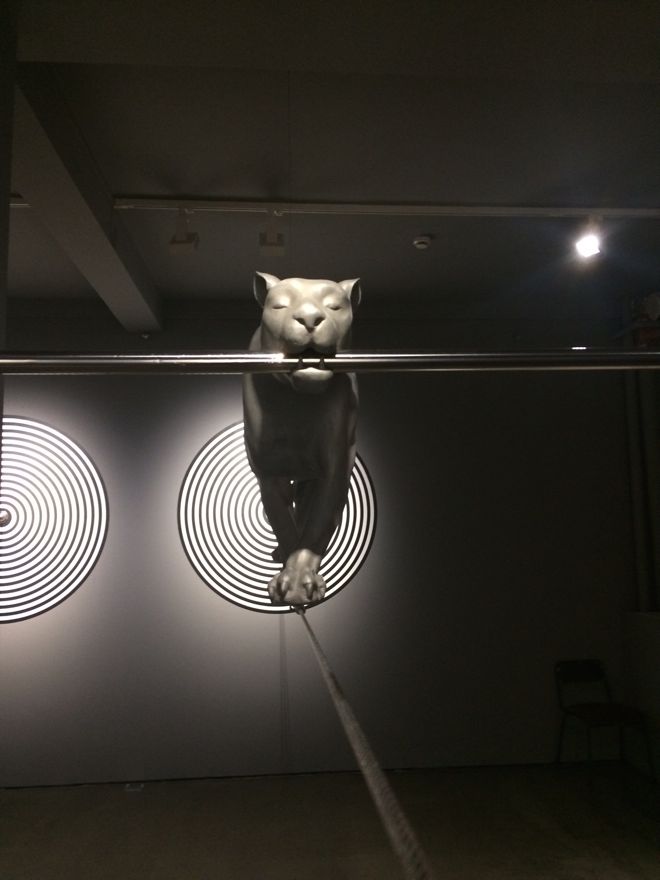Arario Gallery (#1-2, 320 Tianping Road, Xuhui District, Shanghai, China 200231), Nov 21, 2014–Feb 8, 2015
The moment I lift the black curtain at the entrance to Arario Gallery and enter Gao Lei’s solo exhibition, I am confronted with an astounding scene: two aluminum leopards suspended in parallel within the gallery space. Their supple forms are balanced in mid-air via thin steel wires connected to their legs and a horizontal stainless steel flagpole held in their mouths. The steel wires are affixed to the center of the black-and-white bull’s eye mounted on the opposite wall. Two rectangular copper mesh banners are hanging from either end of the flagpole. Where have I encountered such a scene before? In a truncated dream? In lost fragments of memory? Or in one of Dali’s surreal paintings? The stances of the leopards still retain something of the wildness of the African Serengeti, yet their downcast gazes are devoid of any savage freedom. These tamed beasts are yet another example of the changing relation humanity has with nature—from worshipful fear to dominion over nature. The pole reminds one of a certain idealism; one soon observes that the pole, supine on the floor, has a microphone attached, akin to a tool of surveillance—turning the idealistic clamor into utter silence.
Gao Lei has inserted a beast-taming scene from the circus into his artistic creation. With thin steel wires, he links the relationships between humans and animals of the conqueror and the conquered, the tamer and the tamed. The flagpole, the leopards, and the steel wires beneath their paws intertwine to make up the installation before us; their interdependence also signifies the threat of mutual destruction—if any element within this tableau should come loose, the entire installation will collapse. Nature’s laws favor the fittest, and every animal fights to defend its spot on the food chain. But when humanity’s artificial control intervenes with these natural laws, the resulting unnatural state distorts all growth and destruction into a struggle that changes one’s very nature.
Gao Lei’s parable transforms the savage leopard into a tame circus animal; with some regret, viewers must wonder what tactics had to be employed to coerce these animals into acting against their natures? Punishment, fear, violence, the despair of subjugation, and the gradual transition from fierce resistance to desperate survival. The thin steel wires under the leopards’ paws become a symbol of the co-dependency of individual survival and destruction. This piece is entitled “Room 106” and was first shown in exhibition room number 106 at MOCA (Museum of Contemporary Art), Taipei—which was originally a primary school built by the Japanese during the Japanese colonial period in Taiwan; thus the museum space is informed by its history of subjugation. Much like the tamed leopards, the space is a testament to what the power of consciousness has overcome. The piece’s reappearance at Arario Gallery in Hengshan Fang, Shanghai inspires each viewer standing below the leopards to reflect upon their own process of growth. A more poetic expression of this sentiment may be found in this stanza from Rainer Maria Rilke’s tragic poem about a panther in a zoo:
As he paces in cramped circles, over and over,
the movement of his powerful soft strides
is like a ritual dance around a center
in which a mighty will stands paralyzed
On the second floor of the exhibition, one wall of the gallery is covered by large rectangles formed of many saw blades. Forcefully welded into a collective, these sharp and unruly blades have been stripped of individuality. Here, we catch glimpses of how generations of hot blooded and rebellious youth gradually lose their edge, and become neat and nameless minimalist shadows of themselves. Unlabeled mailboxes mounted on the wall reflect the chill of the post-industrial age, ignoring the poisonous gases being pumped inside them through rubber tubes inserted into their slots. In another installation, the four legs of a giraffe are locked inside a cage, with one half of its body under the control of the metal cage and metal lock; the giraffe’s other half disappears into the confines of a triangular geometric shape symbolizing social structure. Gao Lei’s works embody violence and bondage from outside forces, presenting us with an alien world of bizarre configurations. In that instant when he reveals this mysterious universe, what we truly encounter is an all-too-familiar understanding of power, of control, and of the price paid in growing—domestication and depersonalization.
